Caribbean
Related messages
Which aeolid is this one?
November 1, 2000
From: Phanor Montoya
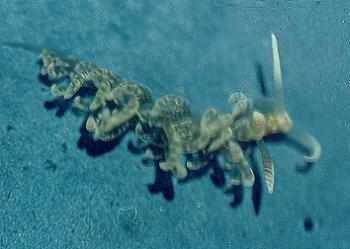
This aeolid was collected from Santa Marta, Colombia. It was 10mm long. The body was creamy white and looks similar to Spurilla neapolitana but I thinks this is not a Spurilla since the ceras aren't curved.
The photos don't help very much to identify this creature but I hope you can say anything about it.
regards
Phanor
phamont@eudoramail.com
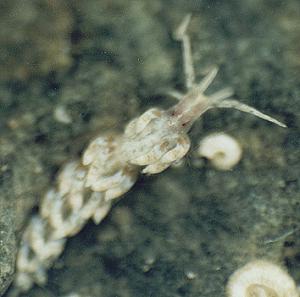
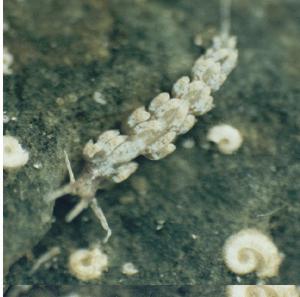
Dear Phanor,
I'm afraid I can't say a lot about this. Is the top photo of the same species as the lower two? The upper photo looks quite like Spurilla and does have curved cerata while the other two look quite different. The upper one has transverse ridges on the rhinophores, but I can't see enough details on the lower two photos to know whether its rhinophores are smooth or not.
Best wishes,
Bill Rudman.
Discodoris evelinae? from Colombia
October 16, 2000
From: Phanor Montoya
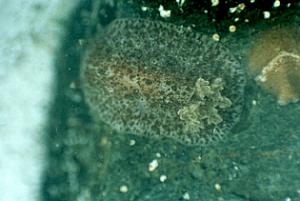
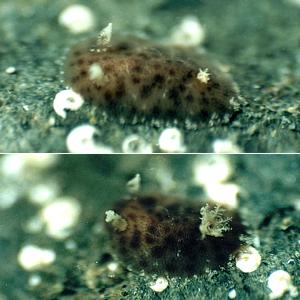
Dear Bill:
I think this nudibranch is Discodoris evelinae. It was collected from Santa Marta, Colombia. I'm sending you photos of what I think are an adult (UPPER) and a juvenile (LOWER). Collected under rocks. The animals are brown or reddish. The body is papillate. They all have six gills.
With regards,
Phanor Montoya
phamont@eudoramail.com
Montoya, P., 2000 (Oct 16) Discodoris evelinae? from Colombia. [Message in] Sea Slug Forum. Australian Museum, Sydney. Available from http://www.seaslugforum.net/find/3129Dear Phanor,
It certainly looks like a Discodoris but let's see what people who know the Caribbean fauna think.
Best wishes,
Bill Rudman.
Tropical American chromodorids
October 13, 2000
From: Bill Rudman
Angel Valdes has sent photos of 4 chromodorids to accompany his message about Phanor Montoya's Colombian chromodorid.
• C. binza
• C. britoi
• C. clenchi
• C. neona.
I have also just posted photos from Jeff Goddard of 3 eastern Pacific species.
• C. norrisi
• Glossodoris sedna
• Glossodoris dalli.
Best wishes,
Bill Rudman.
Nudibranch records from Colombia
October 8, 2000
From: Phanor Montoya
Dear Bill:
Thanks again for your help! Now, I have found about 15 diferent species of opisthobranchs here in Santa Marta, Colombia. I will be sending you some of the photos that I took of them.
I have read Marcus and other scientist's Caribbean opisthobranch work looking to see if the species that I have found have been reported for Colombia, but they just report them for the Caribbean and don't specify which countries. If you know where can I found if these species are new for Colombia please let me know.
Thanks again!
Phanor
phamont@eudoramail.com
Montoya, P., 2000 (Oct 8) Nudibranch records from Colombia. [Message in] Sea Slug Forum. Australian Museum, Sydney. Available from http://www.seaslugforum.net/find/3098Dear Phanor,
Thanks for the photos you have sent. I will put them on the Forum over the next few days. One place you will find countries listed is in Eveline Marcus's Checklist:
Marcus, Ev. (1977) An annotated checklist of the Western Atlantic warm water opisthobranchs. Journal of Molluscan Studies. Supplement 4. November 1977. 1-22.
Best wishes,
Bill Rudman.
Caribbean identifications
September 2, 1999
From: Anne DuPont

Dear Bill,
Thanks so much for posting the nudibranchs on your site. It was great to read the response.
Here are the names of three books I find useful. One problem however is how different books use different scientific names.
Reef Creature Identification, Florida-Caribbean-Bahamas
by Paul Humann
Edited by Ned Deloach
Fourth Printing, 1996
ISBN 1-878348-01-9
Published by New World Publications and
Printed by Paramount Miller Graphics, in Jacksonville, Fl.
Paul's book is the best ID book for Atlantic and Caribbean nudibranchs. He has over 30 nudibranchs identified. Here is a scan of a page to show how it is arranged.
The Audubon Society Field Guide to North American Seashore Creatures
by Norman A. Meinkoth, Professor Emeritus of Zoology, Swarthmore College
ISBN # 0-394-51993-0
published by Alfred A. Knopf, Inc.
I also like to use this book. It has over 30 Nudibranch and flatworms in it. I recommend it highly to you and you probably can get it fromn www.amazon.com. It has good color plates.
Marine Life, Caribbean-Bahamas-Florida
by Marty Snyderman & Clay Wiseman, ISBN
1-881652-06-8, by Aqua Quest Publications, NY.
His book is good for a variety of Carribbean Identifications but he only has 2 nudibranchs photos in his book.
Cordially,
Anne
adupont@gate.net
DuPont, A., 1999 (Sep 2) Caribbean identifications. [Message in] Sea Slug Forum. Australian Museum, Sydney. Available from http://www.seaslugforum.net/find/1280Dear Anne,
Thanks for the information on these books. hopefully it will be helpful for Phanor and anyone else unfamiliar with the fauna.
Lack of consistency with names is a problem with most nudibranch faunas around the world. There are two problems. Firstly as we get a better idea of the evolutionary relationships between animals we often need to rearrange the way we group species into genera and families. The first word in a scientific name, (the genus name) indicates which other species we think are most closely related. For example species of Chromodoris are considered more closely related to each other than they are to species of Hypselodoris, another genus in the Family Chromodorididae. So name changes can be a sign that someone is at last studying a particular group of nudibranchs.
Unfortunately name changes, or different names in different books, can also mean that the authors haven't a clue what they are doing. Colour photography and cheap colour printing has progressed much more quickly than knowledge of opisthobranchs. The Sea Slug Forum isn't planning to replace books, but it is a good place to test identifications you are not sure of. As you have seen, with the help of all participants, we have a pretty good record at putting a name on most photos that appear on the Forum.
Rudman, W.B., 1999 (Sep 2). Comment on Caribbean identifications by Anne DuPont. [Message in] Sea Slug Forum. Australian Museum, Sydney. Available from http://www.seaslugforum.net/find/1280Looking for Caribbean opisthobranch information
August 30, 1999
From: Phanor Montoya
If anyone knows where I can get information about what kind of opisthobranch could be found in the Caribbean coast of South America, specially Colombia, please let me know.
Phanor Montoya
phamont@go.com
Montoya, P., 1999 (Aug 30) Looking for Caribbean opisthobranch information. [Message in] Sea Slug Forum. Australian Museum, Sydney. Available from http://www.seaslugforum.net/find/1246Dear Phanor,
I have just seen your message to the Forum asking for information on Caribbean nudibranchs. Did you get my earlier message?
I am afraid there is little more to add. There are no good books on the Caribbean opisthobranch fauna, and the scientific literature is not very comprehensive, or very good, many descriptions being based on preserved animals.
I repeat my earlier suggestion. If you can send scanned photos to the Forum I will post them up. If there are people who can identify them, I am sure they will reply to you. If you are unable to scan photos, you can post them to me and I will scan them and return them to you.
My postal address is:
The Australian Museum
6 College St,
Sydney,
NSW 2010
Australia.
Best wishes,
Bill Rudman.
